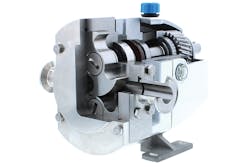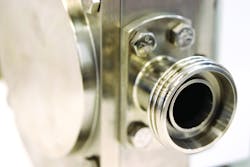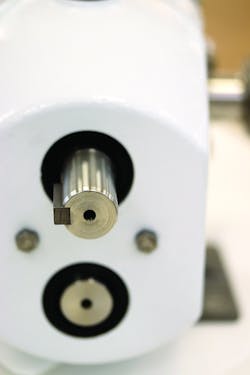Operating within today’s competitive business environment, companies need efficient, effective and reliable technology solutions that support smooth operations. Simple, user-friendly maintenance that keeps downtime and labor costs to a minimum is highly desirable for pump operators working in the pressurized industrial and food and beverage sectors. Simultaneously, businesses within these regulated sectors must ensure that operations are regularly and effectively maintained and serviced.
Rotary lobe pumps are widely used within many industries including the food and beverage, dairy, personal care and health care industries. The popularity of these pumps across diverse industries is due to their sanitary qualities, high efficiency, reliability, corrosion resistance and good clean-in-place/sterilize-in-place (CIP/SIP) characteristics. Rotary lobe pumps with front-loading single-shaft seals are simple in design and fully accessible without disturbing the process pipework, so they are quick and simple to service and maintain. Ease of maintenance delivers benefits including reduced downtime, increased production time and easy cleaning using minimal water/cleaning agents.
When selecting a pump, considerations for price, effectiveness and efficiency are all important factors, but these should not overshadow the importance of user-friendly maintenance that contributes to increased production time and reduced downtime.
Cleaning in place versus manual cleaning (strip clean)
In many applications — such as food, pharmaceutical, chemical and industrial — fast and effective cleaning is important. Living contaminants such as bacteria and other organisms must not be introduced or allowed to multiply, and all traces of fluid must be removed at the end of a batch, process or at product changeover to prevent any intermixing.
In order to clean a pump or other piece of "closed" equipment, it must either be dismantled (manual cleaning), or cleaned in place as part of the procedure for cleaning the entire process. The type of cleaning required depends on the needs of the process. For example, organic materials such as oils, fats and proteins require a different cleaning system compared to inorganic materials such as mineral salts.
Detergent manufacturers can give advice on the correct use of chemicals and temperature. CIP usually needs a velocity of 1.5 meters/second (5 feet/second) through the pipeline to achieve the turbulent flow required.
An advantage of manual cleaning is that no special pipework or equipment (tank, heater, etc.) is needed. However, CIP is becoming more common as it offers advantages over manual cleaning, including the aforementioned benefits of reduced downtime, more time to dedicate to production and a quick and simple cleaning process that any team member can carry out.
Figure 2. The Hy-Line Plus is equipped with front-loaded mechanical seals that are simple in design and fully accessible without disturbing the process pipework.
Step-by-step cleaning in place
The following steps occur in a CIP process:
Step 1. Rinse through system with a suitable liquid, usually water at approximately 50°C (120°F), as soon as possible after completion of process to remove the bulk of residues before they dry onto surfaces.
Step 2. If CIP will not be carried out immediately after rinsing, leave pump and system full of rinse liquid.
Step 3. Choose chemical cleaning agents to suit the nature of the contamination to be removed, and use them in accordance with manufacturers’ recommended dilution, temperature and circulation time. Do not exceed 90°C (195°F). Confirm compatibility with pump materials of construction.
Step 4. CIP fluid flow should result in a mean pipeline velocity of at least 1.5 meters/second (5 feet/second). Note that all pumps are more susceptible to cavitation when pumping hot liquids. Ensure that adequate net inlet pressure is available. If using a separate pump to circulate CIP fluids, the lobe pump may need to be rotated at a speed sufficiently high enough to allow the fluid to pass through freely. If sufficient pipe velocity cannot be achieved, fit a bypass loop to divert excess flow past the pump.
CIP fluid pressures must equal or exceed process pressure at all points in the system to ensure fluid reaches all contact surfaces. To achieve this, it may be necessary to restrict flow in discharge pipework, but do not exceed differential pressure or temperature suitable for the pump. A minimum differential pressure of 1 bar is recommended for effective cleaning.
Step 5. After CIP, rinse through with neutralizers and clean water to remove all traces of cleaning agents. Do not pass cold liquid through the pump immediately after hot; allow the temperature to change slowly. Failure to observe can result in pump seizure.
Application example: Confectionery manufacturing
The global confectionery market is one of the strongest performing sectors globally and expected to reach $232,085 million by 2022, according to Allied Market Research. In Europe, chocolate confectionery, specifically, showed the highest growth rate in recent years, accounting for more than one-third of the market.
When one of Europe’s leading chocolate confectionery companies needed to find an innovative and hygienic solution for a challenging glucose pumping application, the company turned to Xylem. Pumping delicate, viscous fluids can be a daily challenge for confectionery producers. If an ill-performing pump is used, the effects on productivity and product quality can be costly.
Chocolate processing and seal selection
Double mechanical seal arrangements with a high-pressure food grade* barrier, or flush, are recommended for applications handling premium-quality chocolate products. Alternatively, packed gland seal arrangements can be used where a controlled amount of product leakage is acceptable at the back of the rotor case. The level of cocoa content in the chocolate product may also determine which arrangement is most suitable, e.g., high cocoa content products are more valuable and place a higher demand on sealing methods than lower cocoa content chocolates due to the abrasive nature of cocoa.
Throughout chocolate processing, temperature control is key to maintaining quality; temperature is also important to maintaining the pump head. Temperature control jackets are recommended to protect pump head temperature variation from sources such as low ambient temperatures and thermal transfer from the pump gearbox.
Figure 3. The keyway drive of the Hy-Line Plus helps keep the pump shaft and motor aligned, reducing the risk of repairs.
The project
Many confectionery manufacturers use high quantities of glucose, transporting it from tankers to internal canisters for use in the production processes.
In this case, the manufacturer had been using a legacy gear pumping system for this purpose, but wanted to upgrade to a more reliable, efficient and hygienic solution.
External gear pumps are widely used in hydraulic fluid power applications as well as in chemical installations to pump high viscosity fluids. These pumps use two meshing and contacting gears to pump fluid by displacement — the gear in the pump head turns the other gear. Despite their popularity, gear pumps can have a downside: the potential wear of gear material into pumped media.
The solution
The manufacturer chose two Xylem Jabsco Hy-Line Plus hygienic rotary lobe pumps specifically designed for the food industry and ideal for tank filling and emptying. Unlike with external gear pumps, the lobes do not make contact, and their gentle pumping action preserves the quality of ingredients, while the AISI 316 stainless steel construction makes them durable and food-grade compliant.*
The pumps include a front-loaded mechanical seal system that offers time and cost savings if maintenance is required on the pump. Changing a seal on a front-loaded pump can be completed within 15 minutes, compared to three or four hours on a non-front-loaded seal pump.
The hygienic rotary lobe pumps can be used for ingredient unloading and transfer, tank filling and emptying, recirculation and mixing, portion and container filling and sampling and filtration — suited for food and dairy applications as well as breweries.
Pleased with the results, the manufacturer is also considering using the technology for its chocolate processing applications with the packed gland version of the Jabsco Hy-Line Plus lobe series. The packed gland is a convenient, cost-effective sealing solution used in chocolate manufacturing. It is ideal for processing chocolate in its thick liquid form and transferring it throughout the whole production process — from chocolate liquor to the conching process, to the molding of chocolate bars.
Footnote
*All food contact materials fall within the scope of two pieces of European legislation:
- Regulation (EC) 1935/2004 on materials and articles intended to come into contact with food, also known as the Framework or FCM Regulation.
- Regulation (EC) 2023/2006 on good manufacturing practices for materials and articles intended to come into contact with food, also known as the GMP Regulation. Any material considered to be an FCM will need to comply with this legislation.
Peter Wright is director of product management and engineering for Xylem’s Specialty Flow Control business, which includes the Jabsco, Rule and Flojet brands and serves the marine, industrial and beverage sectors. Since joining Xylem in 2005, Wright has held positions in product management, marketing, business development and strategy. He earned a bachelor’s degree in physics from Bristol University and an Executive MBA from Henley Business School in the U.K.




